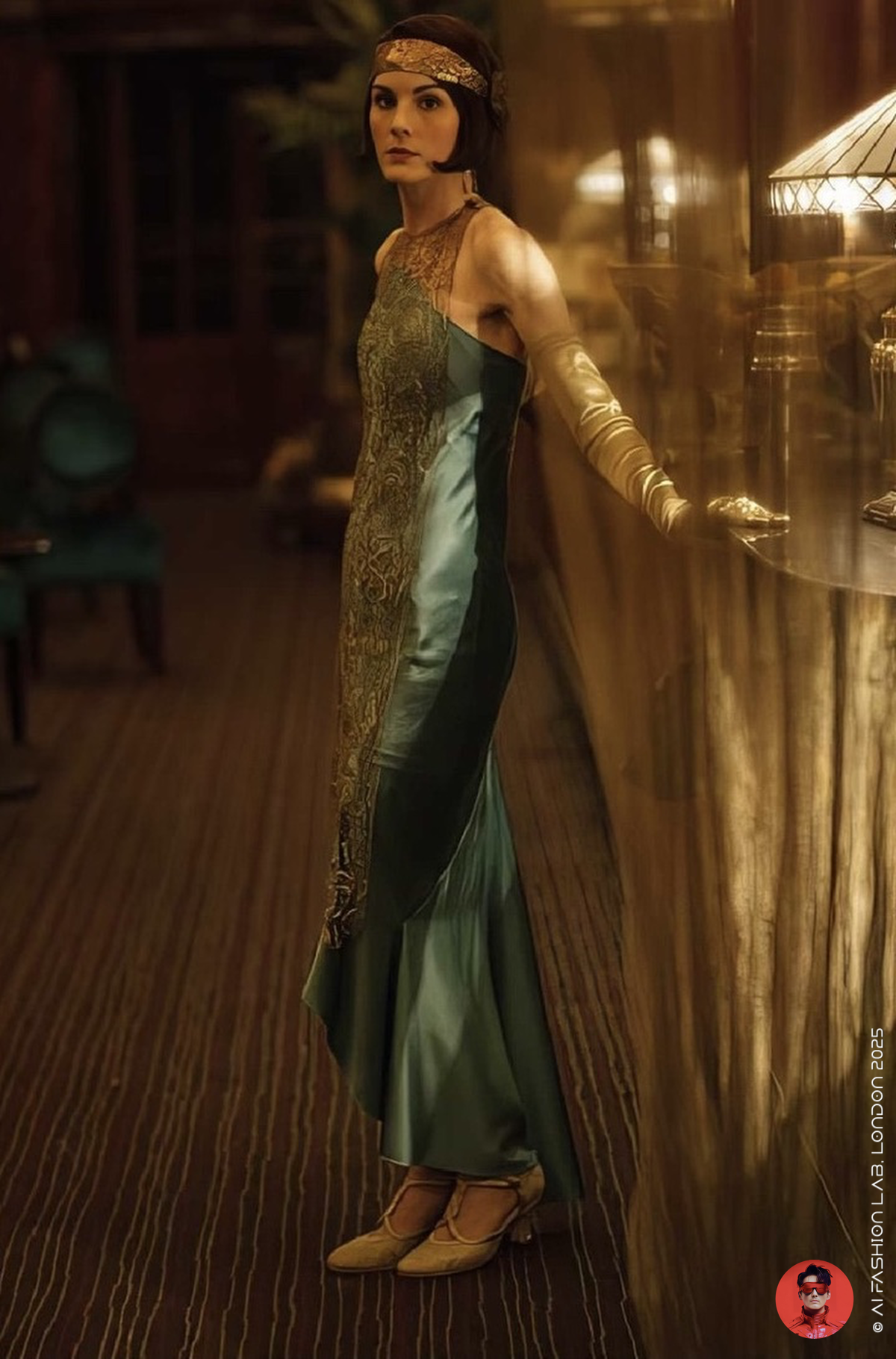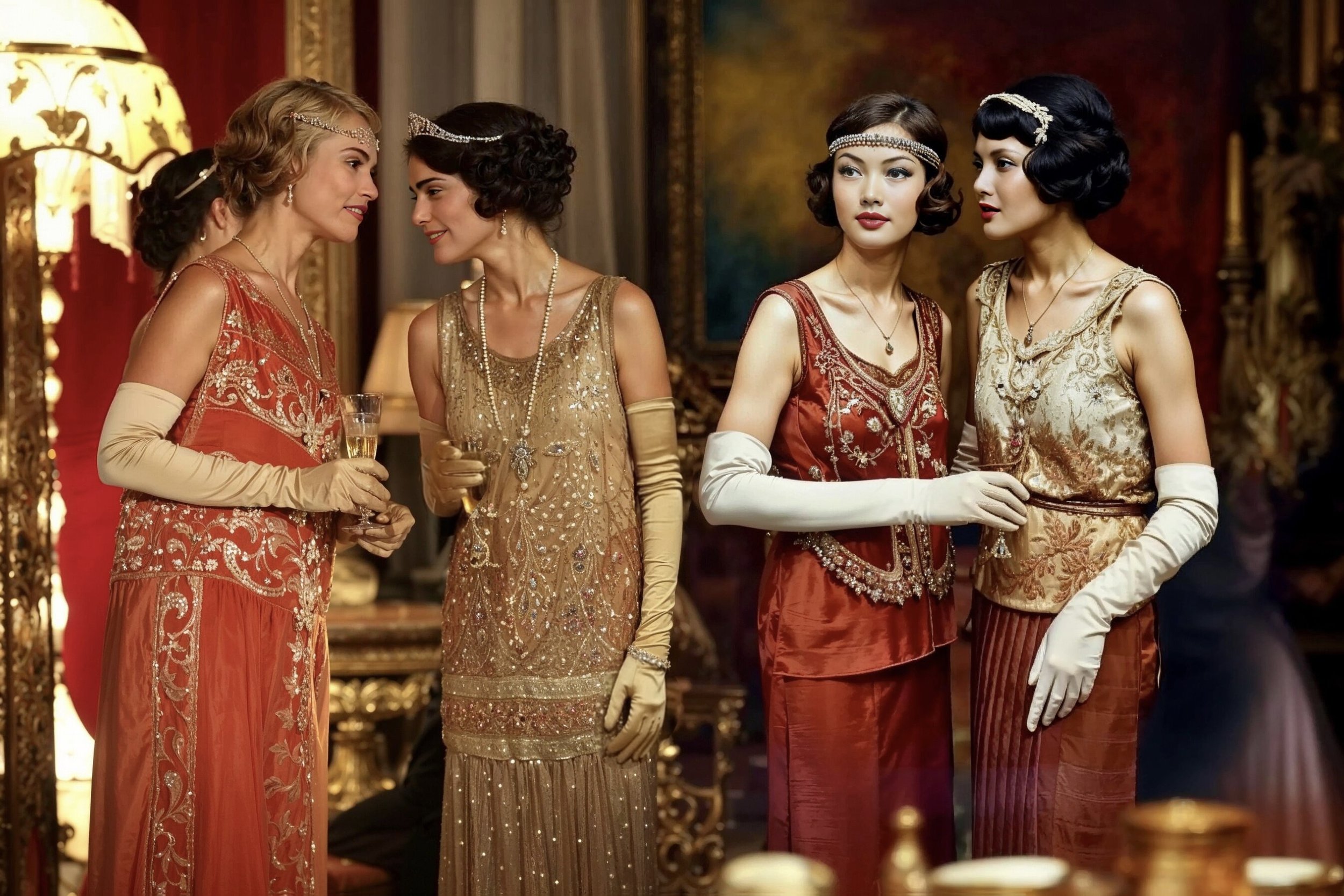ถอดรหัสแฟชั่น Downton Abbey: เมื่อความงามยุค 1920 สู่สไตล์ไทยในสมัยรัชกาลที่ ๖ ตอนปลาย
ถอดรหัสแฟชั่น Downton Abbey: เมื่อความงามยุค 1920 สู่สไตล์ไทยในสมัยรัชกาลที่ ๖ ตอนปลาย
แฟชั่นในยุค 1920 ถือเป็นเสน่ห์ที่ไร้กาลเวลา สะท้อนถึงยุคแห่งการเปลี่ยนแปลง ความสง่างาม และนวัตกรรมเสื้อผ้า ในฐานะนักออกแบบเครื่องแต่งกาย ผมมักได้รับแรงบันดาลใจจากยุคที่โดดเด่นนี้ซึ่งผสมผสานความเรียบง่ายเข้ากับความซับซ้อนได้อย่างลงตัว ด้วยความก้าวหน้าทาง AI ผมสามารถสร้างสรรค์ผลงานที่สอดคล้องกับแฟชั่นในยุคนั้นได้อย่างสมจริง ทั้งในบริบทของตะวันตกที่แฟชั่นเฟื่องฟูที่สุดในยุคแจ๊ซ (ค.ศ. 1920–1929) และในบริบทของไทยซึ่งสอดคล้องกับช่วงปลายรัชสมัยพระบาทสมเด็จพระมงกุฎเกล้าเจ้าอยู่หัว (รัชกาลที่ ๖, พ.ศ. ๒๔๕๓–๒๔๖๘ / ค.ศ. 1910–1925) ต่อเนื่องถึงรัชสมัยพระบาทสมเด็จพระปกเกล้าเจ้าอยู่หัว (รัชกาลที่ ๗, พ.ศ. ๒๔๖๘–๒๔๗๗ / ค.ศ. 1925–1935) ซึ่งนับเป็นช่วงที่แฟชั่นตะวันตกได้รับการถ่ายทอดและปรับเข้ากับราชสำนักไทยอย่างงดงามและหลากหลาย
คอลเล็กชันที่ผมตื่นเต้นที่จะแบ่งปันในวันนี้คือการนำแรงบันดาลใจจากสไตล์อันโดดเด่นของซีรีส์ Downton Abbey มาปรับให้เข้ากับบริบทของไทย Downton Abbey เป็นซีรีส์ที่มีชื่อเสียงซึ่งเล่าเรื่องราวของครอบครัวชนชั้นสูงชาวอังกฤษในช่วงต้นศตวรรษที่ 20 และผู้คนในคฤหาสน์ของพวกเขา การออกแบบเครื่องแต่งกายในซีรีส์นี้โดดเด่นและได้รับการยกย่องอย่างมาก โดยเฉพาะการถ่ายทอดความเปลี่ยนแปลงจากความหรูหราสไตล์ Edwardian ไปสู่เส้นสายที่ทันสมัยและเรียบง่ายของยุค 1920
ตัวละครหญิง 3 คนหลักในซีรีส์ ได้แก่ แมรี่ อีดิธ และโรส ต่างมีสไตล์ที่โดดเด่นแตกต่างกัน แมรี่มีสไตล์ที่สง่างามและเรียบหรู สะท้อนถึงความมั่นใจและสง่าผ่าเผยของเธอ อีดิธแต่งตัวในสไตล์อ่อนหวาน โรแมนติก มักมีรายละเอียดปักลายละเอียดอ่อนในโทนสีพาสเทล ขณะที่โรสสะท้อนความกล้าหาญและความสนุกสนานของยุคฟลอปเปอร์ด้วยชุดที่ดูทันสมัยและร่าเริง รวมกันแล้วพวกเธอเป็นตัวแทนของความงามสง่าของแฟชั่นยุค 1920 ในฝั่งตะวันตกได้อย่างสมบูรณ์แบบ
ด้วยแรงบันดาลใจจากดีไซน์เหล่านี้ ผมได้ฝึกโมเดล AI ให้สามารถปรับเปลี่ยนและดัดแปลงดีไซน์เหล่านี้ให้เข้ากับบริบทแบบไทยได้ ผลลัพธ์ที่ได้คือความเพลิดเพลินในการสร้างสรรค์ภาพในคอลเล็กชันนี้ครับ โมเดล AI ที่เทรนขึ้นมาไม่เพียงแค่รักษาความงดงามของดีไซน์ต้นแบบเอาไว้ แต่ยังเพิ่มความเป็นเอกลักษณ์แบบไทยเข้าไปอีกด้วย เช่น ในขณะที่ชุดเดรสของฝั่งตะวันตกอาจเน้นลวดลายสไตล์ Art Deco และเลื่อมระยิบระยับ การปรับให้เข้ากับบริบทแบบไทยได้นำเสนอผ้าไหมไทย และการออกแบบแบบปักดิ้นที่สะท้อนถึงความสง่างามของเครื่องแต่งกายราชสำนักไทยในยุคนั้น นอกจากนี้ เครื่องประดับอย่าง bandeau ก็ได้รับการตีความใหม่ เช่นเครื่องประดับเพชรหรือเครื่องประดับทองที่ประณีต
ผมเริ่มต้นด้วยการรวบรวมภาพถ่ายดิจิทัลจากหอจดหมายเหตุแห่งชาติของไทย โดยเฉพาะภาพถ่ายจากแผ่นกระจกที่นิยมในช่วงต้นศตวรรษที่ 20 ภาพเหล่านี้มีรายละเอียดและคุณภาพที่โดดเด่น ทำให้เป็นฐานข้อมูลที่สมบูรณ์แบบ ผมเริ่มต้นด้วยการใช้ AI ในการลงสีภาพขาวดำเหล่านี้ให้เป็นภาพสี กระบวนการนี้ใช้เวลานาน แต่ก็คุ้มค่าที่จะทำเพื่อให้ได้ภาพที่สมบูรณ์แบบที่สุด
การเทรนโมเดล Flux LoRA ได้กลายเป็นเครื่องมือที่ดีสำหรับการสร้างสรรค์ดีไซน์หลากหลายรูปแบบ ช่วยให้กระบวนการทำงานรวดเร็วขึ้นและประหยัดเวลามากเมื่อเทียบกับการร่างแบบด้วยมือในทุกแนวคิด อย่างไรก็ตาม ทุกผลงานจะต้องผ่านการตรวจสอบ แก้ไข และปรับแต่ง เพื่อให้แน่ใจว่าเป็นไปตามวิสัยทัศน์ของผม AI ไม่ได้มาแทนที่นักออกแบบ แต่เป็นเครื่องมือที่ช่วยเสริมศักยภาพในการสร้างสรรค์งาน
บ่อยครั้งมีความเข้าใจผิดว่า การใช้ AI จะลดบทบาทของนักออกแบบลง แต่ผมมองต่างออกไป AI ขึ้นอยู่กับข้อมูลที่มันได้รับการฝึกฝน และในกรณีของผม ชุดข้อมูลเหล่านี้ถูกสร้างขึ้นด้วยการค้นคว้า การลงสี และการเตรียมการอย่างพิถีพิถัน AI จึงทำงานอยู่ในกรอบที่ผมสร้างขึ้น และสะท้อนถึงความเชี่ยวชาญและการออกแบบของผู้ฝึกฝนโมเดลตัวนั้น AI ควรถูกมองว่าเป็นเครื่องมือ เช่นเดียวกับแปรงวาดภาพหรือจักรเย็บผ้าที่ช่วยให้นักออกแบบสร้างงาน ไม่ใช่สิ่งที่มากำหนดชิ้นงานแทนเรา
ลองจินตนาการถึง Downton Abbey ในเวอร์ชันไทย ที่เกิดขึ้นในยุค 1920 ชุดเครื่องแต่งกายจะต้องสะท้อนถึงความงามของยุคนั้น พร้อมทั้งเน้นย้ำถึงเอกลักษณ์ทางวัฒนธรรมของไทย และด้วยความช่วยเหลือจาก AI กระบวนการออกแบบชุดเหล่านี้จะง่ายขึ้นและเต็มไปด้วยจินตนาการ ผมเข้าใจว่าทำไมบางสตูดิโอภาพยนตร์ถึงลังเลที่จะให้ใช้ AI ในการออกแบบเครื่องแต่งกาย เนื่องจากข้อกังวลเรื่องลิขสิทธิ์ แต่เมื่อเราใช้ชุดข้อมูลของเราเองและควบคุมกระบวนการสร้างสรรค์ ผลงานที่ได้ก็เป็นของเราโดยสมบูรณ์ เช่นเดียวกับภาพวาดที่เป็นของจิตรกร ไม่ใช่บริษัทที่ผลิตสี
ผมได้คัดสรรคอลเล็กชันนี้ขึ้นมาอย่างตั้งใจ เพื่อให้ผู้อ่านได้เพลิดเพลินไปกับการเปรียบเทียบระหว่างแฟชั่นต้นฉบับจากซีรีส์ Downton Abbey กับการแปลความงามเหล่านั้นให้เข้ากับบริบทไทย โดยเริ่มจากภาพต้นฉบับ แล้วตามด้วยภาพที่ผมสร้างขึ้นใหม่ผ่านโมเดล AI เพื่อให้เห็นถึงความแตกต่างและความคล้ายคลึงกันของซิลูเอตต์ ลวดลาย และรายละเอียดการตกแต่งในแต่ละชุด
Decoding Downton Abbey Fashion: Translating 1920s Elegance into Thai Style in the Late Reign of King Rama VI
Fashion in the 1920s holds a timeless allure, reflecting an era of transformation, elegance, and innovation in clothing. As a costume designer, I often find inspiration in this remarkable decade, which masterfully blends simplicity with sophistication. With advances in AI, I am now able to create works that authentically reflect the fashion of that period—both in the West, during the height of the Jazz Age (1920–1929), and in Thailand, where the same period corresponds with the late reign of King Rama VI (r. 1910–1925) and the reign of King Rama VII (r. 1925–1935), a time when Western fashion was gracefully adopted and adapted within the Thai royal court.
The collection I am excited to share today draws inspiration from the distinctive fashion of the television series Downton Abbey, reimagined through the lens of 1920s Thai style. Downton Abbey is a celebrated drama that chronicles the lives of a British aristocratic family and their household staff in the early 20th century. The series is renowned for its exquisite costume design, which beautifully captures the transition from Edwardian grandeur to the sleek, modern silhouettes of the 1920s.
The three leading female characters—Mary, Edith, and Rose—each exhibit a unique personal style. Mary’s look is elegant and understated, reflecting her confidence and composure. Edith dresses in a softer, romantic manner, often featuring pastel tones and delicate embroidery. Rose, in contrast, embodies the boldness and playfulness of the flapper era with cheerful, contemporary outfits. Together, these characters represent the full spectrum of 1920s Western fashion.
Inspired by these distinct design approaches, I trained my AI model to reinterpret and adapt them within a Thai cultural context. The result has been a joyful creative process. The AI model I developed does more than preserve the beauty of the original designs—it adds a distinctly Thai identity. While Western evening gowns might feature shimmering sequins and Art Deco motifs, the Thai adaptations incorporate traditional Thai silk and intricate gold-thread embroidery reminiscent of royal attire from that era. Accessories such as the bandeau have also been reinterpreted with ornate diamond or gold embellishments, offering a refined Thai perspective on familiar silhouettes.
I began this work by sourcing high-resolution digital photographs from the National Archives of Thailand, focusing especially on early 20th-century glass plate negatives. These images are rich in detail and quality, making them a valuable foundation for historical reference. I then used AI to colourise the black-and-white photos—a time-consuming process, but one that proved deeply rewarding in recreating authentic visual material.
Training the Flux LoRA model became a powerful tool in generating a diverse range of costume designs. It significantly accelerated my workflow compared to sketching every concept by hand. Still, each output underwent careful review, adjustment, and refinement to ensure it aligned with my creative vision. AI is not a replacement for designers—it is an enhancement, expanding what we can imagine and produce.
There is often a misconception that using AI diminishes the role of the designer, but I see things differently. AI relies entirely on the data it is trained on, and in my case, that data was built through dedicated research, colourisation, and curation. The model works within a framework I designed, and it reflects my expertise and artistic direction. AI should be viewed as a tool—like a paintbrush or a sewing machine—that helps bring a designer’s vision to life, not a force that overrides it.
Imagine Downton Abbey in a Thai version, set in the 1920s. The costumes would need to honour the elegance of the period while also highlighting Thailand’s unique cultural identity. With the support of AI, the process of designing such garments becomes both more efficient and more imaginative. I understand why some film studios may hesitate to embrace AI in costume design, often due to concerns about copyright. However, when we use our own curated datasets and maintain full creative control, the resulting work is entirely our own—just as a painting belongs to the artist, not the company that manufactured the paint.
I have carefully curated this collection for your enjoyment, beginning with original references from Downton Abbey, followed by my AI-generated interpretations in Thai style. This side-by-side presentation allows you to appreciate both the differences and similarities in silhouettes, patterns, and decorative details, revealing how cultural translation can breathe new life into historical fashion.
#aifashionlab #AI #aiartist #aiart #aifashion #aifashiondesign #aifashionstyling #aifashiondesigner #fashion #fashionhistory #historyoffashion #fashionstyling #fashionphotography #digitalfashion #digitalfashiondesign #digitalcostumedesign #digitaldesign #digitalaiart #ThaiFashionHistory #ThaiFashionAI






























































